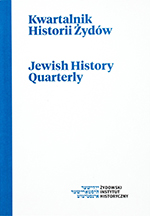Od Jehudy Halewiego do Johanna Buxtorfa Młodszego: Sefer ha-bahir w żydowskiej i chrześcijańskiej debacie na temat punktacji masoreckiej
From Yehuda ha-Levi to Johannes Buxtorf the Younger: Sefer ha-bahir in the Jewish and Christian Discourse on Masoretic Punctuation
Author(s): Jan DoktórSubject(s): Jewish Thought and Philosophy, History of Judaism
Published by: Żydowski Instytut Historyczny
Keywords: Bible; Masoretic punctuation; Kabbalah; Christian Hebrew studies; Sefer ha-bahir
Summary/Abstract: The Masoretes of Tiberias, who determined the binding consonant text of the Tanakh as well as vocalizing it, preformed a virtual revolution in the Judaic world, which also had serious implications for religions stemming from the Biblical tradition, first of all Christianity, and to a smaller extent for Islam, too. By presenting the final, as it appeared, comprehensible and unequivocal text of the Revelation, the Masoretes were raising the status of the Hebrew Bible to the rank of a firm, immovable foundation of religions, especially the Jewish religion. The theological implications for Christianity were far-reaching too: the established text of the Bible undermined the status of the binding translations of same: the Greek Septuagint in the Eastern churches and the Latin Vulgata in the Roman Catholic Church, which had been translated from other versions of the Hebrew text.In the debates on the significance of the mesorah it was crucial to establish whether the punctuation constituted a part of Moses’ revelation or whether it was added to the text of the Bible later and as such, would not be an object of faith. The Christian students of Hebrew were critical of this “novelty,” which undermined the prestige of the Vulgata and even falsified the Biblical prophecies at many places. Most of the Jewish scholars sought to enhance the prestige of both the text as determined by the Masoretes and the vocalization proposed by them. It was much the same with the Kabbalah. The first Kabbalist print in which the Masoretic signs were discussed and interpreted at length was Sefer ha-bahir. Its editors regarded the Masoretic signs as a key to the understanding of creation and redemption. A similar position was taken by Sefer ha-zohar and other writings. It was only in the mid-16th century that the grammarian Elias the Levite began to argue that the Masoretic punctuation must have been devised already after the edition of the Talmud. The Christian students of Hebrew were similarly divided as regards the Masoretic punctuation: the Protestant theologians began to support the antiquity of the mesorah, while contradicting the Catholic theologians, who still regarded the vocalization signage as a Jewish “novelty” and defended the authority of the Vulgata. When embarking on a public dispute with the critics of the revealed nature of the mesorah, the Calvinist students of Hebrew referred to Jewish sources and sought to make them available to the public at large. Johannes Buxtorf the Younger published Sefer Kuzari in Basel in 1660 in a bilingual version. However, he dared not publish Sefer ha-bahir himself, having presumably decided that it will be more practical for the Jews themselves to do it. That task was undertaken by the first Ashkenazic printing house in Amsterdam, with the help of Calvinist scholar Jacob Bartolin. This must have been the reason why the text was not printed using the rashi font, typically employed for this kind of texts and also used in subsequent editions of the Bahir, but a square type, which was easier for a non-Jewish reader to read.
Journal: Kwartalnik Historii Żydów
- Issue Year: 263/2017
- Issue No: 03
- Page Range: 357-379
- Page Count: 23
- Language: Polish

